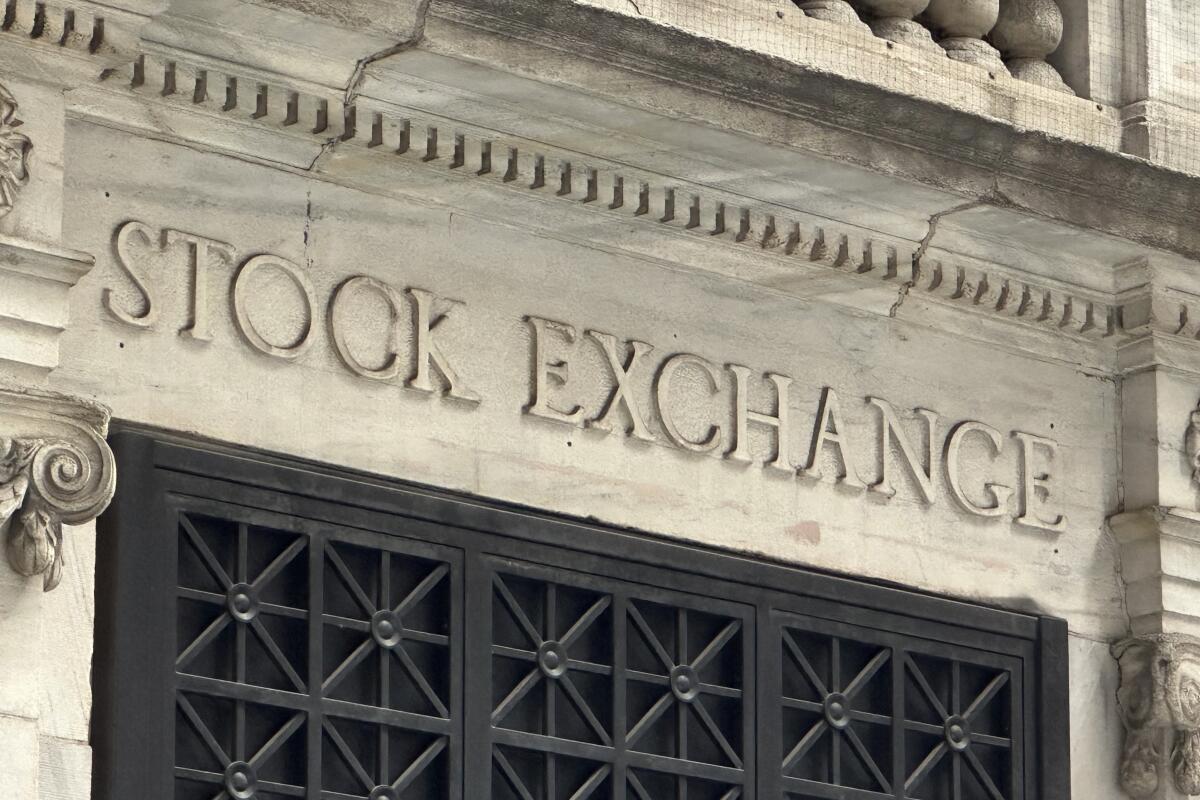Wall Street coasts to the close of another winning week as Nvidia cools again

- Share via
NEW YORK — U.S. stocks coasted to the close of their latest winning week on Friday, as Nvidia ’s stock continued to cool from its startling, supernova run.
The Standard & Poor’s 500 slipped 0.2%, but it remained close to its all-time high set on Tuesday and capped its eighth winning week in the last nine. The Dow Jones industrial average edged up 15 points, or less than 0.1%, while the Nasdaq composite dropped 0.2%.
Nvidia again dragged on the market, falling 3.2% on Friday. The company’s stock has soared more than 1,000% since October 2022 on frenzied demand for its chips, which are powering much of the world’s move into artificial intelligence technology. It briefly supplanted Microsoft this week as the most valuable company on Wall Street.
But nothing goes up forever, and Nvidia’s drops the last two days sent the stock to its first losing week in the last nine.
Much of the rest of Wall Street was relatively quiet, except for a few outliers.
Sarepta Therapeutics jumped 30.1% after U.S. regulators approved the use of its medicine for children with Duchenne muscular dystrophy who are at least 4.
Gun maker Smith & Wesson Brands tumbled 12.9% despite reporting stronger profit for the latest quarter than analysts expected. The summer is traditionally a slower season for firearms, according to Chief Executive Mark Smith.
Shares of Trump Media & Technology Group rallied back from an early loss and rose 3.4%, trimming its loss for the week to 25.3%. The company behind Donald Trump’s Truth Social platform had seen its stock nearly halve since the conviction of the former president in late May on charges in a scheme to illegally influence the 2016 election through a hush money payment to a porn actor who said the two had had sex.
All told, the S&P 500 dipped 8.55 points to 5,464.62. The Dow Jones industrial average rose 15.57 points to 39,150.33, and the Nasdaq composite dropped 32.23 points to 17,689.36.
In the bond market, U.S. Treasury yields initially fell after a report suggested business activity among countries that use the euro currency is weaker than economists expected. Concerns are already high for the continent ahead of a French election that could further rattle financial markets.
The weak business activity report dragged down yields in Europe, which at first pressured Treasury yields. But U.S. yields recovered much of those losses after another report said later in the morning that U.S. business activity may be stronger than thought.
Overall output growth hit a 26-month high, according to S&P Global’s preliminary reading of activity among U.S. manufacturing and services businesses. Perhaps more important for Wall Street, that strength may be happening without a concurrent rise in pressure on inflation.
“Historical comparisons indicate that the latest decline brings the survey’s price gauge into line with the Fed’s 2% inflation target,” according to Chris Williamson, chief business economist at S&P Global Market Intelligence.
The Federal Reserve is in a precarious spot; it’s trying to slow the economy by raising interest rates just enough to get high inflation back down to 2%. The trick is that it wants to cut interest rates at the exact right time. If it waits too long, the economy’s slowdown could careen into a recession. If it’s too early, inflation could reaccelerate.
Hope still reigns among traders that the Fed can pull it off, and many are forecasting at least two cuts to interest rates later this year, according to data from CME Group. Of course, their predictions have regularly proved to be overly optimistic through history.
Fed officials themselves have penciled in one or two cuts in 2024 to their main interest rate, which has been sitting at its highest level in more than two decades. The economy is still growing, though it has slowed recently under the weight of high rates. Housing and manufacturing have been hurt in particular, while lower-income households are struggling to keep up with still-rising prices.
The yield on the 10-year Treasury edged down to 4.25% from 4.26% late Thursday. The yield on the two-year Treasury, which more closely tracks expectations for Fed action, dipped to 4.73% from 4.74%.
In stock markets abroad, European stocks fell after the weak continental economic reports, and many Asian indexes were also lower. Hong Kong’s Hang Seng dropped 1.7%, and South Korea’s Kospi fell 0.8%.
More to Read
Inside the business of entertainment
The Wide Shot brings you news, analysis and insights on everything from streaming wars to production — and what it all means for the future.
You may occasionally receive promotional content from the Los Angeles Times.










